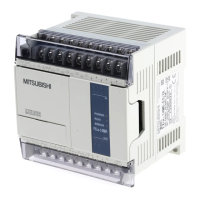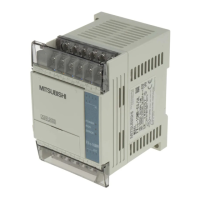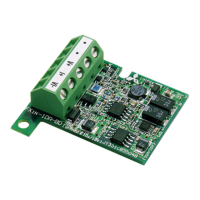FX Series Programmable Controlers Applied Instructions 5
5-127
PID Equations
PV
nf
=PV
n
+ α(PV
nf-1
-PV
n
)
EV
n
= the current Error Value D
n
= the Derivative Value
EV
n-1
= the previous Error Value D
n-1
= the previous Derivative Value
SV = the Set Point Value (S
1
)K
P
= the Proportion Constant
PV
n
= the current Process Value (S
2
) α = the Input Filter
PV
nf
= the calculated Process Value T
S
= the Sampling Time
PV
nf-1
= the previous Process Value T
I
= the Integral Time Constant
PV
nf-2
= the second previous Process Value T
D
= the Time Derivative Constant
∆MV = the change in the Output K
D
= the Derivative Filter Constant
Manipulation Values
MV
n
= the current Output Manipulation Value (D)
Please see the Parameter setup section for a more detailed description of the variable
parameters and in which memory register they must be set.
Forward and Reverse operation (S
3
+1, b0)
The Forward operation is the condition where the Process Value, PV
nf
, is greater than the Set
Point, SV. An example is a building that requires air conditioning. Without air conditioning, the
temperature of the room will be higher than the Set Point so work is required to lower PV
nf
.
The Reverse operation is the condition where the Set Point is higher than the Process Value.
An example of this is an oven. The temperature of the oven will be too low unless some work
is done to raise it, i.e. - the heating element is turned On.
The assumption is made with PID control that some work will need to be performed to bring
the system into balance. Therefore, ∆MV will always have a value. Ideally, a system that is
stable will require a constant amount of work to keep the Set Point and Process Value equal.
Forward
PV
nf
>SV
Reverse
SV > PV
nf
∆MV K
P
EV
n
( EV
n1–()
– )
T
S
T
I
------
EV
n
D
n
++
îþ
íý
ìü
=
EV
n
PV
nf
SV–=
D
n
T
D
T
S
K
D
T
D
⋅+
-------------------------------
2PV–
nf 1–
PV
nf
PV
nf 2–
++()
K
D
T
D
⋅
T
S
K
D
T
D
⋅+
-------------------------------
D
n1–
⋅+=
MV
n
∆MV
å
=
∆MV K
P
EV
n
EV
n1–
–()
T
S
T
I
------
EV
n
+D
n
+
îþ
íý
ìü
=
EV
n
SV PV
nf
–=
D
n
T
D
T
S
K
D
+T
D
⋅
-------------------------------
=2PV
nf 1–
PV
nf
–PV
nf 2–
–()
K
D
T
D
⋅
T
S
K
D
+T
D
⋅
-------------------------------
+D
n1–
⋅
MV
n
∆MV∆
å
=

